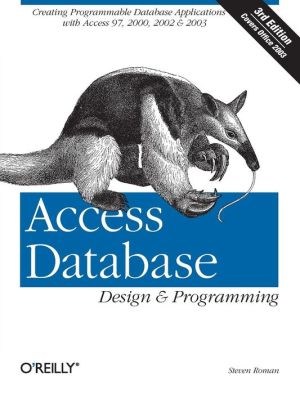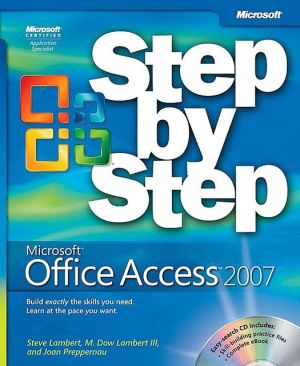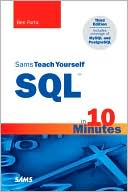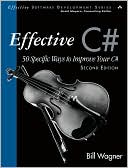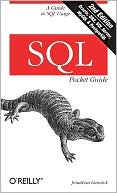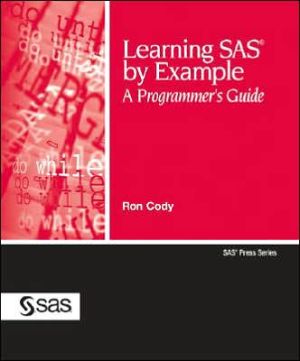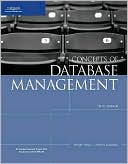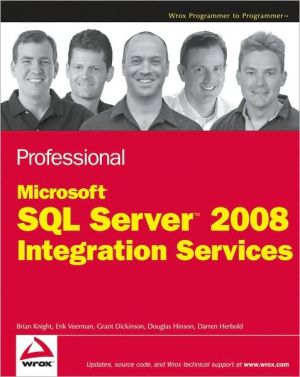Access Database Design and Programming
Access Database Design & Programming takes you behind the details of the Access interface, focusing on the general knowledge necessary for Access power users or developers to create effective database applications. When using software products with graphical interfaces, we frequently focus so much on the interface that we forget about the general concepts that allow us to understand and use the software effectively. In particular, this book focuses on three areas:\ \ Database design. The...
Search in google:
For programmers who prefer content to frills, this guide has succinct and straightforward information for putting Access to its full, individually tailored use. Duncan Making Access More Accessible From an industry observer's point of view, Microsoft Access-97 is a potent symbol of many of the things that have made Microsoft despised, feared, and enormously successful: determination, persistence, nearly unlimited resources, disregard for backward compatibility, contempt for open standards, fragmented design, lack of quality assurance and software engineering, and, of course, the ability to leverage its software suites, massive bankroll, and control of the operating system platform to outmarket, outmaneuver, outlast or simply gobble up the competition. But from a purchaser's point of view, Access is mostly a symbol of Microsoft's unilateral decision to ship its gigantic powerful complex software products with virtually no printed documentation at all. Consequently, the would-be Access developer's first act is typically to run down to the nearest technical bookstore and try to find something that explains how the darn thing works. Unfortunately, the third-party market for Microsoft Access books is split between simple beginner-oriented books that teach users how to design forms and reports using the built-in wizards and controls, and recycled Visual Basic books that describe Access as a sort of Visual Basic clone with some grafted-on database function calls. There has been, until now, a conspicuous absence of books that approach Access from a database analyst and developer's point of view -- books that explain how Access implements relational database concepts, its data definition language, its object model (such as it is), and its degree of compliance with ANSI standard SQL. Steven Roman's Access Database Design and Programming goes a good part of the distance toward filling this void. It starts with a discussion of entity-object relationships, keys and superkeys, and normal forms, then goes on to introduce relational algebra, query languages, and SQL. A brief diversion into Visual Basic for Applications and its relationship to the Jet Database Engine is followed by a fairly extensive explanation of Access's family of objects, collections, and properties -- always one of Access's most confusing and least stable characteristics. The book closes with two chapters on programmatic data definition and data manipulation in Access, topics which often receive short shrift in the recycled Visual Basic books I alluded to earlier. This is not a very long book, and the code examples are fairly trivial, but it will save you a lot of time and frustration if you are just getting started with Access database development.--Dr. Dobb's Electronic Review of Computer Books
PrefacePt. IDatabase Design1Introduction32The Entity-Relationship Model of a Database113Implementing Entity-Relationship Models: Relational Databases184Database Design Principles35Pt. IIDatabase Queries5Query Languages and the Relational Algebra516Access Structured Query Language (SQL)81Pt. IIIDatabase Architecture7Database System Architecture115Pt. IVVisual Basic for Applications8The Visual Basic Editor, Part I1299The Visual Basic Editor, Part II13710Variables, Data Types, and Constants14611Functions and Subroutines16512Built-in Functions and Statements17313Control Statements191Pt. VData Access Objects14Programming DAO: Overview20115Programming DAO: Data Definition Language24116Programming DAO: Data Manipulation Language254Pt. VIActiveX Data Objects17ADO and OLE DB26918ADOX: Jet Data Definition in ADO326Pt. VIIProgramming Problems19Some Common Data Manipulation Problems337App. ADAO 3.0/3.5 Collections, Properties, and Methods361App. BThe Quotient: An Additional Operation of the Relational Algebra378App. COpen Database Connectivity (ODBC)381App. DObtaining or Creating the Sample Database401App. E: Suggestions for Further Reading411Index413
\ DuncanMaking Access More Accessible\ From an industry observer's point of view, Microsoft Access-97 is a potent symbol of many of the things that have made Microsoft despised, feared, and enormously successful: determination, persistence, nearly unlimited resources, disregard for backward compatibility, contempt for open standards, fragmented design, lack of quality assurance and software engineering, and, of course, the ability to leverage its software suites, massive bankroll, and control of the operating system platform to outmarket, outmaneuver, outlast or simply gobble up the competition. But from a purchaser's point of view, Access is mostly a symbol of Microsoft's unilateral decision to ship its gigantic powerful complex software products with virtually no printed documentation at all.\ Consequently, the would-be Access developer's first act is typically to run down to the nearest technical bookstore and try to find something that explains how the darn thing works. Unfortunately, the third-party market for Microsoft Access books is split between simple beginner-oriented books that teach users how to design forms and reports using the built-in wizards and controls, and recycled Visual Basic books that describe Access as a sort of Visual Basic clone with some grafted-on database function calls. There has been, until now, a conspicuous absence of books that approach Access from a database analyst and developer's point of view -- books that explain how Access implements relational database concepts, its data definition language, its object model (such as it is), and its degree of compliance with ANSI standard SQL.\ Steven Roman's Access Database Design and Programming goes a good part of the distance toward filling this void. It starts with a discussion of entity-object relationships, keys and superkeys, and normal forms, then goes on to introduce relational algebra, query languages, and SQL. A brief diversion into Visual Basic for Applications and its relationship to the Jet Database Engine is followed by a fairly extensive explanation of Access's family of objects, collections, and properties -- always one of Access's most confusing and least stable characteristics. The book closes with two chapters on programmatic data definition and data manipulation in Access, topics which often receive short shrift in the recycled Visual Basic books I alluded to earlier.\ This is not a very long book, and the code examples are fairly trivial, but it will save you a lot of time and frustration if you are just getting started with Access database development.--Dr. Dobb's Electronic Review of Computer Books\ \ \
